Blue Value™ / Rose Value™
Blue Value™ — Environmental Contributions

Earth blue
Instead of green, which is associated with nature and ecology, blue represents something much bigger—the earth.
It is also our corporate color and signifies harmony with the global environment and our contributions to society.
The Goal of Blue Value™
The Mitsui Chemicals Group, whose Corporate Mission is “harmony with the global environment,” lists “a circular society in harmony with the environment” as one of its ideal future society and aims to realize this through its business activities. The Group belongs in the upstream process and provides products and services broadly to a variety of industries, and their environmental impact on the society is complex and wide-ranging. That is why, in order to truly contribute to the ideal future society through business activities, the Group believes it is important to share with its various stakeholders, including direct and indirect customers, the impact on and contributions of its products and services towards the global environment throughout their life cycles. Based on this idea, Blue Value™ was designed to evaluate the environmental impact throughout the life cycle, and to visualize the value.

*1 Life cycle assessment (LCA):
A technique to quantitatively assess environmental impacts associated with all the stages of a product’s life, from raw materials, to manufacturing, processing, use, and disposal.
*2 LIME2 (Life-cycle Impact assessment Method based on Endpoint modeling):
Damage assessment-type lifecycle environmental impact assessment method based on environmental conditions in Japan.
Sharing environmental contributions through Blue Value™
With Blue Value™, the environmental contributions the products and services provide throughout the life cycle can be visualized.
For example, Blue Value™ certified products related to the automobile industry reduce environmental impact not only in processes that the Mitsui Chemicals Group is directly involved in, such as raw materials procurement and manufacturing, but also in various life stages, including intermediate processing where it is indirectly involved, as well as the use and disposal of the end products.
Maximization of environmental contributions throughout the Life Cycle
- Hypothetical Case: Products Used in Automobiles -

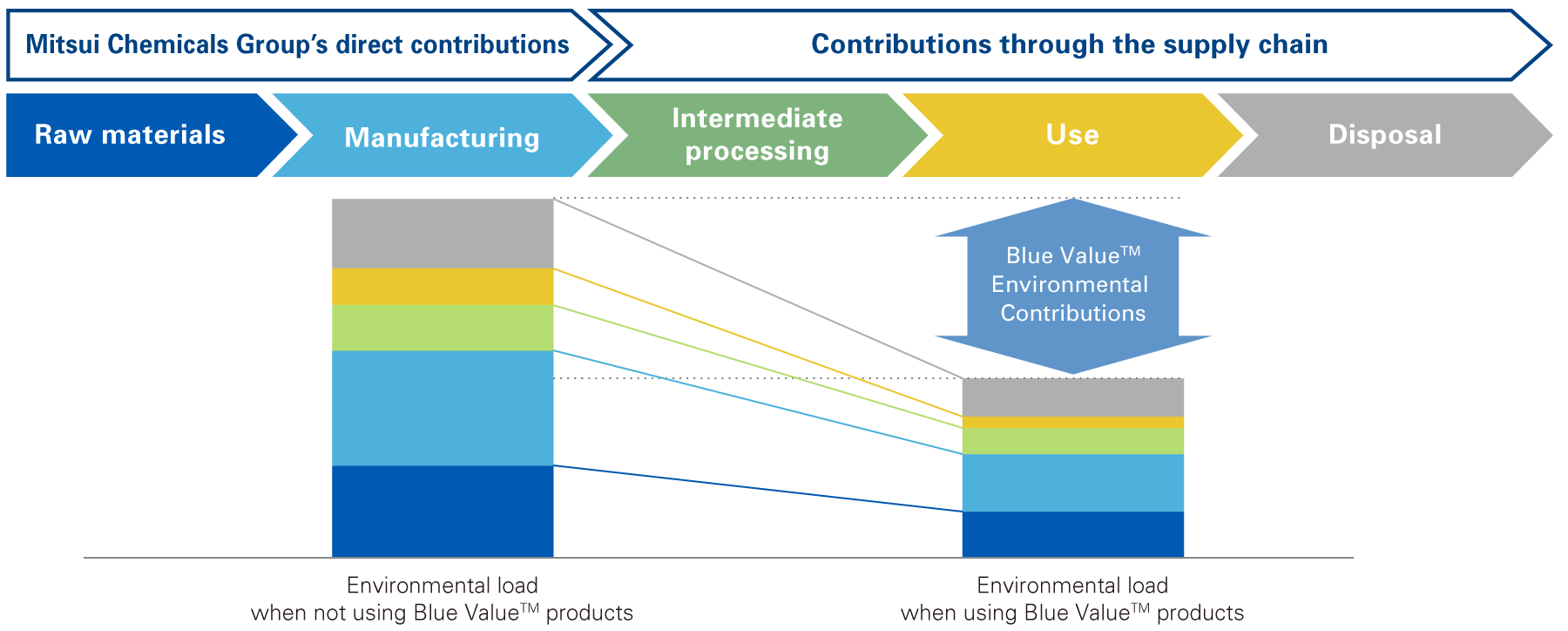
*The image is a hypothetical case and may differ from information on actual products of our Group.
The Group aims to maximize the environmental contributions generated from implementation of Blue Value™ products and services in the society, by sharing this value or “Blue Value™” with various stakeholders throughout the life cycle.
Blue Value™ Assessment Index and Certification Criteria
Blue Value™ assessments Blue Value™ candidate products and services based on the three contributing factors of “reducing CO2,” “conserving resources,” and “coexisting with nature.” The Blue Value™ Index, our unique assessment index that is a simplified version of LIME2, is established for each of the contribution factors, and candidate products and services are compared with general products in the market and the company's own conventional products to evaluate their environmental impact throughout their life cycles. Blue Value™ products and services are certified through discussions by the review board based on criteria that in addition to the environmental contributions being recognized at a sufficient level throughout the life cycle in more than one of the three contribution categories, no negative impact occurs in any of the contribution categories.
Evaluation using the Blue Value™ Index is qualitative or semi-quantitative, but there is a system for collaborating with the department responsible for LCA to conduct a stricter and quantitative assessment whenever required.
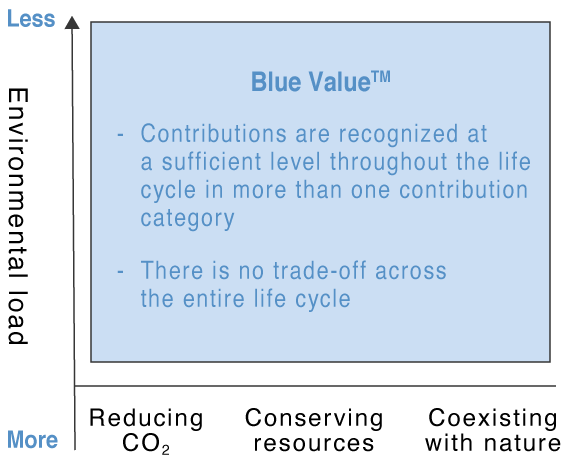
Environmental Impact Assessment Index — Blue Value™ Index
| Contribution categories | Blue Value™ Index | |
|---|---|---|
| Assessment index | Related assessment items | |
|
Reducing CO2 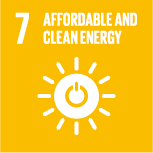



|
|
|
|
Conserving resources 



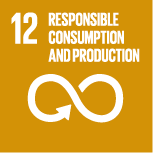
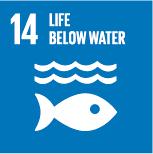
|
|
|
|
Coexisting with nature 





|
|
|
| Contribution categories | Related assessment items |
|
|---|---|---|
| Blue Value™ Index Assessment index |
||
|
Reducing CO2 |
|
|
|
||
|
Conserving resources |
||
|
||
|
Coexisting with nature |
||
|
||
*Related assessment criteria are evaluated on contributions to any one of the assessment index.
*GHG emission-related global warming substances, chemical substances harmful to ecosystems, and environmental pollutants are all substances for which characterization factors have been calculated in LIME2.
Example of Blue Value™ Evaluation, Review, and Certification
Target Product: AdBlue™*1
Application: NOx reducing additive
Comparison: Vehicle equipped with urea SCR system vs Vehicle not equipped with urea SCR system
![]() This table is scrollable.
This table is scrollable.
| Contribution category | Evaluation based on Blue Value™ Index | Review criteria | Certification decision | ||||||
|---|---|---|---|---|---|---|---|---|---|
| Raw materials | Manufacturing | Intermediate processing | Use | Disposal | |||||
| Coexisting with nature | Reduced NOx emissions | Throughout the life cycle | Reduced emission of environmental pollutants | The product can achieve these | ○ | ||||
| Confirmed that emission of NOx (substance for which characterization factors have been calculated in LIME2) and the like can be reduced by equipping with urea SCR system | |||||||||
| Reducing CO2 | (1) Increased GHG from manufacturing AdBlue™, etc. | (2) Improved fuel efficiency Secondary effect*2 | Reduced GHG emissions | ○ | |||||
| Confirmed that the GHG reduction effect from improved fuel efficiency while driving exceeds the increase in GHG emissions from manufacturing the urea SCR system and AdBlue™ ((1) < (2)) | |||||||||
*1 AdBlue™:
“High-grade aqueous urea” used in diesel engine cars equipped with urea SCR system which reduces nitrogen oxides (NOx) contained in exhaust gas. Under strict quality control, we manufacture and supply the highest quality AdBlue™ made from 100% pure domestic urea and deionized water. The raw material urea is manufactured in our Osaka Works, with a firm supply system that is not easily impacted by external factors.
*AdBlue™ is a registered trademark of the VDA (Verband der Automobilindustrie)
*2 Secondary effect:
Internal combustion engine used in combination with the urea SCR system is designed as a high-temperature combustion, which improves fuel efficiency compared to conventional internal combustion engines and reduces GHG emissions.
The product concept of AdBlue™ is the reduction of NOx in exhaust gas when used in diesel engine cars equipped with the urea SCR system. Results from evaluation based on the Blue Value™ Index show that environmental impact (urban air pollution and acidification) improved by about five folds, which led to its certification as a Blue Value™ product for its environmental contributions in “Coexisting with nature.” Additionally, vehicles equipped with the urea SCR system using AdBlue™ have improved fuel efficiency compared to vehicles not equipped with the system. Therefore, AdBlue™ is also certified for its environmental contributions in “reducing CO2,” because it contributes to GHG emission reduction. Thus, by evaluating throughout the life cycle using Blue Value™, the content and effects of the environmental contributions are shared with customers and stakeholders.
Expectations from external expert (Blue Value™ advisor)
Decarbonization and a circular economy are central to solving the world's problems, as well as to corporate growth strategies, and businesses need to promote cross-industry eco-innovation. Blue Value™ helps visualize the reduction in environmental impact of products from a product life cycle perspective. This is extremely important information for quickly achieving a carbon neutral and recycling-oriented society. Mitsui Chemicals has adopted the sales revenue ratio of Blue Value™ products as a key performance indicator for its long-term business plan targets, which contributes to the rapid spread of eco-products. So, I strongly support its activities.
Professor,
School of Creative Science and Engineering,
Waseda University
Dr. ITSUBO Norihiro
*Each affiliation is from the time when the article was created.

